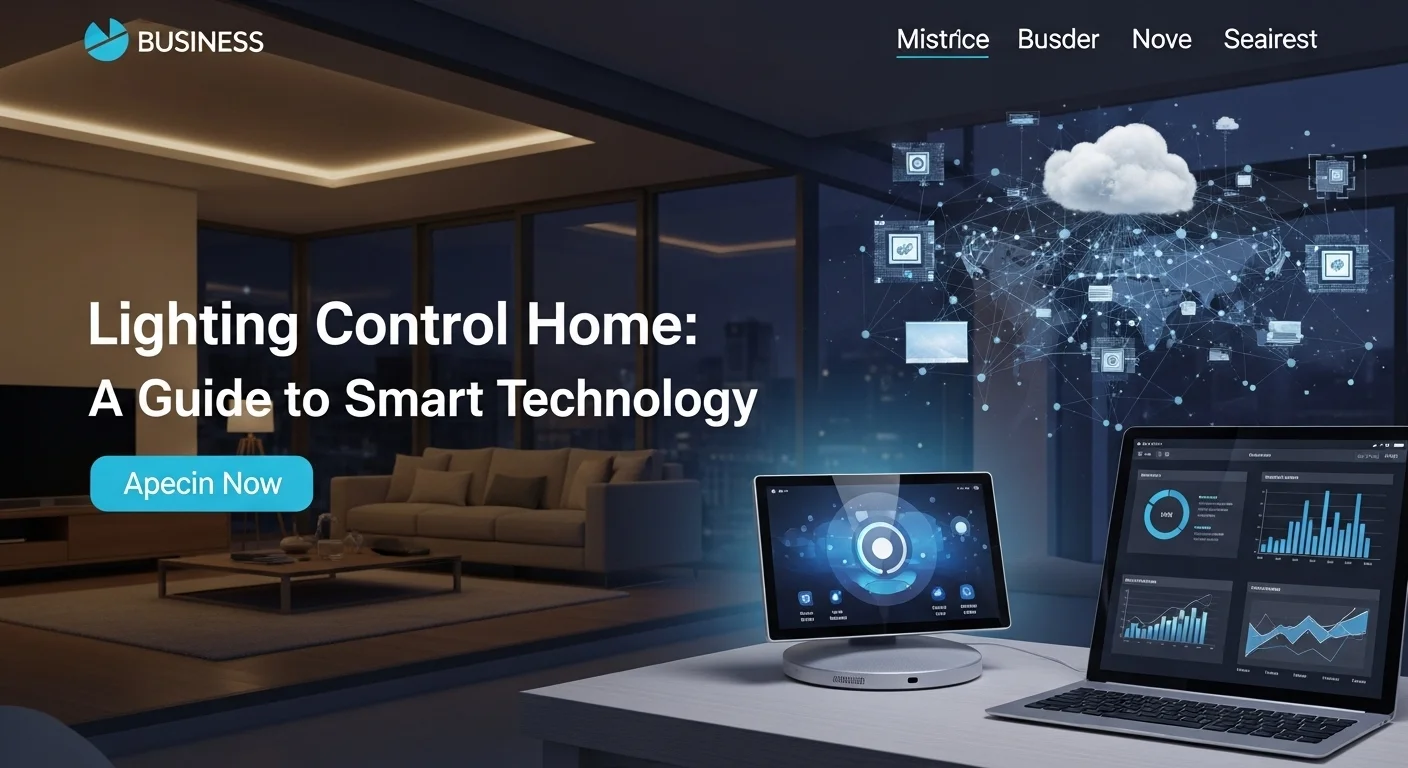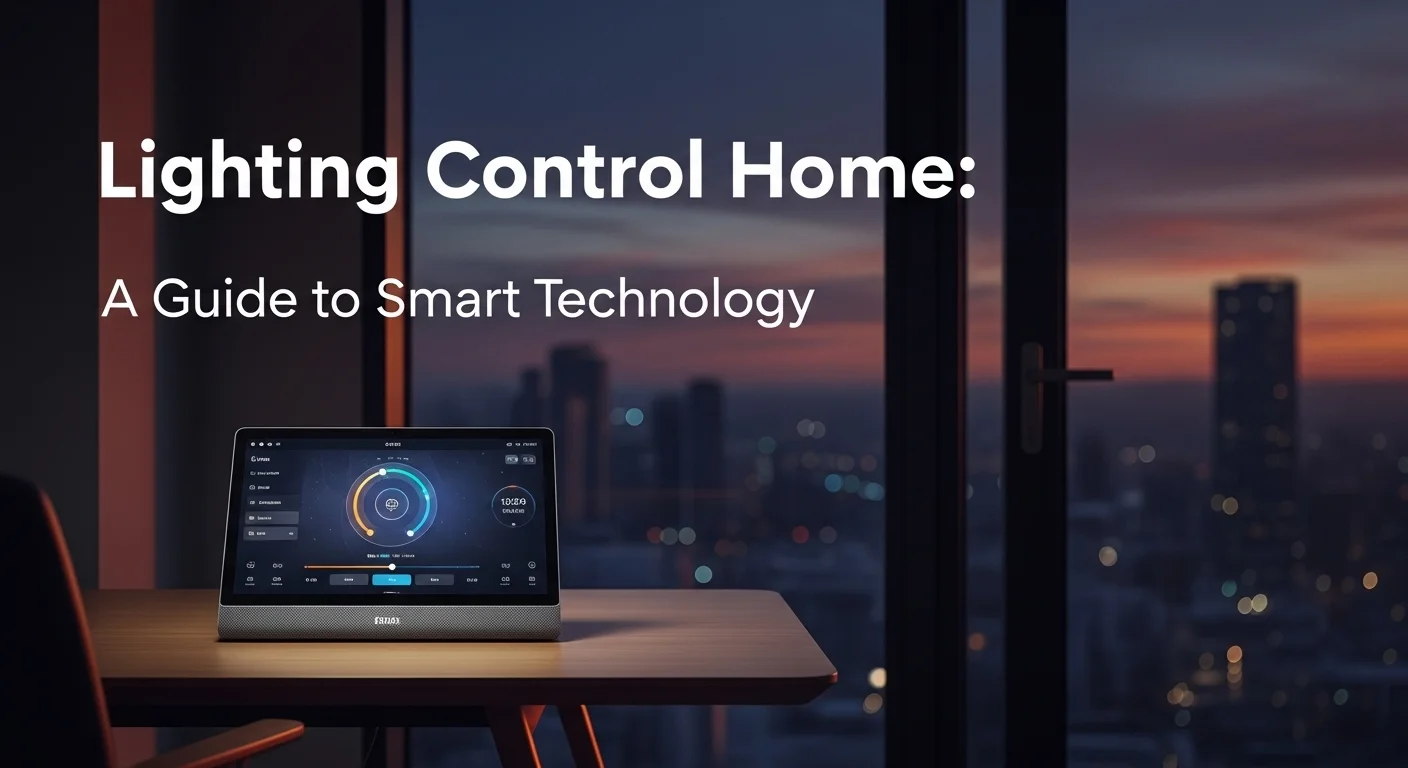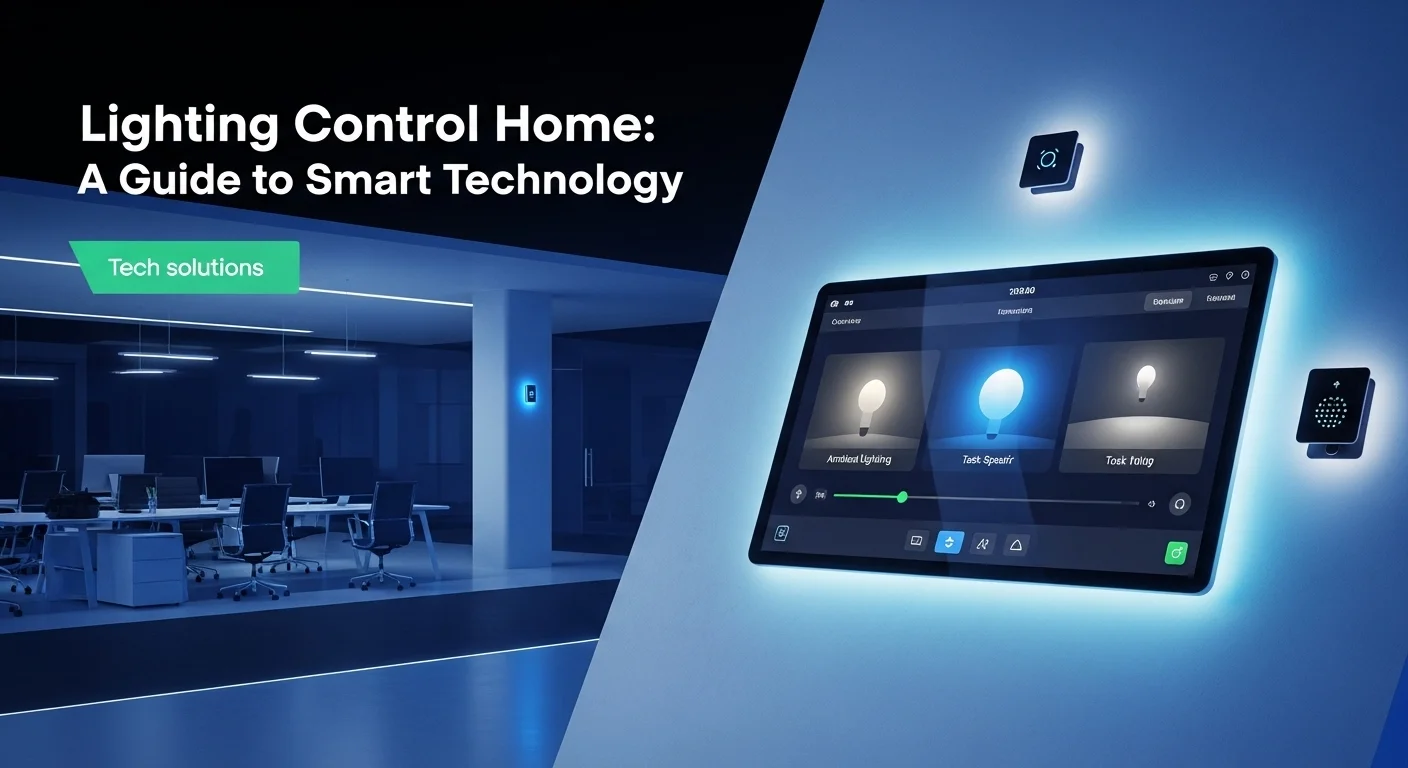Lighting Control Home: A Guide to Smart Technology

Executive Summary
In the rapidly evolving landscape of smart technology, Lighting Control Home stands out as a cornerstone of modern automation, offering more than just convenience. It represents a sophisticated fusion of technology, energy efficiency, and personalized living. For businesses, it opens new avenues in hospitality, retail, and smart office design, allowing for dynamic and responsive environments. For tech enthusiasts, it's a gateway to creating a truly intelligent and intuitive living space. This article delves into the core of home lighting control systems, exploring their technological underpinnings, from wireless protocols like Zigbee and Matter to centralized wired solutions. We will examine the tangible benefits, including significant energy savings, enhanced security, and improved well-being through human-centric lighting. By understanding the components, from the smart bulb to the central home lighting control panel, and the strategies for effective implementation, users can unlock the full potential of this transformative technology. This guide serves as a comprehensive resource for anyone looking to integrate or understand the power of smart home light control in today's tech-driven world.
Table of Contents
What is Lighting Control Home and why is it important in Technology?
The concept of Lighting Control Home has transcended its origins as a luxury feature to become a fundamental component of modern technology and smart living. At its core, a home lighting control system is an intelligent, network-based solution that allows for the management of a home's lighting from a centralized or remote interface. [3] This goes far beyond a simple on/off switch; it involves the ability to dim lights, change their color and temperature, set schedules, and create automated 'scenes' for various activities. [2] The technology leverages a network of connected devices, including smart bulbs, switches, sensors, and controllers, to provide unprecedented command over one of the most crucial elements of our living environment. [1] This network can be as simple as a few Bluetooth-connected bulbs in a single room or as complex as a whole home lighting control systems that integrates every light fixture in a property. [11] The importance of this technology in today's world cannot be overstated, as it sits at the intersection of several key technological trends: the Internet of Things (IoT), energy efficiency, artificial intelligence (AI), and human-centric design.
The technological significance of home lighting control systems lies in their ability to create a more responsive, efficient, and personalized environment. By connecting lights to the internet and a central control system, users can manage their lighting from anywhere in the world via a smartphone app, voice assistant, or a dedicated home lighting control panel. [1] This remote accessibility is a game-changer for both convenience and security. For instance, being able to turn lights on and off while on vacation can create the illusion that someone is home, acting as a powerful deterrent to potential intruders. [15] Furthermore, the integration of sensors—such as motion, occupancy, and daylight sensors—automates the lighting process, ensuring that lights are only on when and where they are needed. [8] This automation is a key driver of energy efficiency, a critical concern in an era of rising energy costs and environmental awareness. LED smart bulbs, which are the foundation of most modern systems, are already about 75% more efficient than traditional incandescent bulbs; when paired with smart controls, the energy savings are compounded significantly. [7] Systems can automatically dim or turn off lights in response to abundant natural daylight (a practice known as daylight harvesting) or when a room is unoccupied, drastically reducing wasted electricity. [12]
Business Applications and Broader Impacts
The applications of this technology extend far beyond the residential sphere, offering substantial value to businesses across various sectors. In the commercial world, these systems are often referred to as intelligent or networked lighting controls and are pivotal for managing large-scale environments. [3, 29] For instance, in an office setting, a sophisticated smart home light control system (adapted for commercial use) can optimize the working environment to boost productivity and employee well-being. By adjusting color temperature throughout the day to mimic natural sunlight, these systems can support employees' circadian rhythms, leading to better focus and reduced fatigue. [6, 21] In retail, dynamic lighting can be used to highlight products, create engaging displays, and guide customer flow through a store. [29] The hospitality industry also benefits immensely, as hotels can use whole home lighting control systems to offer guests a premium, personalized experience, allowing them to set lighting scenes in their rooms with the touch of a button while enabling management to achieve significant energy savings across the property.
Moreover, the data generated by these networked systems is becoming an invaluable asset. In a smart building, the lighting infrastructure can serve as a dense network of sensors, collecting data on occupancy, movement patterns, and environmental conditions. [31] This information can be used to optimize not just lighting but also HVAC systems, space utilization, and even cleaning schedules, leading to more efficient and intelligent building management. [29] The evolution of home lighting control is therefore a critical step towards the broader vision of smart cities, where interconnected systems work together to conserve resources, enhance security, and improve the quality of urban life. The technology is no longer a siloed solution but a foundational layer for a vast range of IoT applications. The central hub for this management is often a physical or digital home lighting control panel, which acts as the command center for these intricate operations, making complex automation accessible to the user. [42] As this technology becomes more standardized and interoperable, particularly with the advent of protocols like Matter, its importance will only grow, cementing its role as an essential element of our connected future.
The Multifaceted Benefits of Smart Lighting Control
The advantages of implementing a Lighting Control Home system are diverse, impacting everything from your wallet to your well-being. The most frequently cited benefit is energy efficiency. By replacing traditional bulbs with LEDs and adding smart controls, homeowners can slash their lighting-related energy consumption by a significant margin. [7] Features like dimming, scheduling, and sensor-based automation ensure that not a single watt is wasted. [20] A simple command or an automated schedule can turn off all lights left on by mistake, a common source of energy waste in any household. [2] This translates directly into lower electricity bills and a reduced carbon footprint.
Convenience is another major driver for adoption. The ability to control every light in your home from a single interface—be it a smartphone app, a voice command to Alexa or Google Assistant, or a sleek wall-mounted home lighting control panel—is a profound lifestyle upgrade. [11, 4] Imagine activating a 'Movie Night' scene that dims the main lights, turns on accent lighting, and perhaps even closes the smart blinds, all with one touch. [2, 5] Or scheduling lights to gradually brighten in the morning for a more natural and pleasant wake-up experience than a jarring alarm clock. [28] This level of automation simplifies daily routines and adds a touch of effortless sophistication to a home.
Security is significantly enhanced with smart home light control. As mentioned, automated lighting schedules can mimic occupancy when you're away, a feature often called 'Vacation Mode'. [15, 28] This is a far more dynamic and convincing deterrent than leaving a single light on a mechanical timer. Furthermore, integration with other security devices can create powerful safety protocols. For example, if a security camera detects motion in the backyard at night, it can trigger all exterior and interior lights to turn on to full brightness, startling intruders and alerting residents. [11] Motion-activated lights in hallways and on stairs also improve safety within the home, preventing trips and falls in the dark. [11]
Finally, the impact on ambiance and well-being is a crucial, though sometimes overlooked, benefit. The ability to tune the color and intensity of light allows you to craft the perfect atmosphere for any occasion—from a bright, energizing light for working from home to a warm, soft glow for relaxing in the evening. [7] This extends to the concept of Human-Centric Lighting (HCL), which uses tunable white light to support our natural circadian rhythms. [6] By providing cool, blue-toned light during the day to promote alertness and warm, amber-toned light at night to signal the body to wind down, home lighting control systems can contribute to better sleep, improved mood, and overall wellness. [21, 25] This focus on health makes lighting control not just a smart technology, but a wellness technology, deeply integrated into the fabric of a healthy home. The sophistication of these setups, especially in whole home lighting control systems, represents a pinnacle of home technology integration.

Complete guide to Lighting Control Home in Technology and Business Solutions
Diving into the world of Lighting Control Home technology reveals a complex and fascinating ecosystem of hardware, software, and communication protocols. Understanding these components is essential for making informed decisions, whether you are a homeowner planning a DIY project or a business looking to implement a large-scale solution. The foundational choice in any system is between a wired and a wireless architecture, each with distinct advantages and use cases.
Wired vs. Wireless: The Architectural Backbone
Wired home lighting control systems, such as those from industry leaders like Lutron (e.g., HomeWorks) and Crestron, are the gold standard for reliability and performance. [2] In these setups, control devices (like keypads and sensors) and lighting fixtures are physically connected via low-voltage wiring to a central processor or a series of panels. [22] This direct connection makes the system incredibly robust and free from the radio frequency (RF) interference that can occasionally plague wireless setups. Wired systems are ideal for new construction or major renovations where running new wires is feasible. [41] They are the preferred choice for large, complex installations, often found in luxury homes and commercial buildings, where flawless operation is paramount. The central brain of these systems allows for intricate programming and seamless integration with other building management systems like HVAC and security. The tangible interface for such a system is often a sophisticated home lighting control panel, offering a clean and permanent control point. [38]
Wireless home lighting control, on the other hand, offers unparalleled flexibility and ease of installation, making it perfect for retrofitting existing homes. [41] These systems utilize RF protocols to communicate between devices. Instead of running new wires, you can simply replace existing switches with smart switches or screw in smart bulbs. This dramatically reduces installation complexity and cost. [2] The most common wireless protocols include:
- Wi-Fi: Many consumer-grade devices connect directly to a home's Wi-Fi router. This is simple and requires no separate hub, but it can crowd the network and may become less reliable if too many devices are connected. [1]
- Zigbee and Z-Wave: These are low-power mesh networking protocols designed specifically for smart home devices. In a mesh network, each device can relay signals to other devices, extending the network's range and improving reliability. They operate on different frequencies from Wi-Fi, reducing interference. These systems typically require a central hub or bridge to connect to your home network and the internet. [20]
- Bluetooth Mesh: Similar to Zigbee and Z-Wave, Bluetooth Mesh creates a many-to-many device network, which is highly reliable and scalable. It's becoming increasingly popular for lighting control due to its low power consumption and direct phone-to-device control capabilities. [3]
- Matter: Formerly known as Project CHIP, Matter is a new, open-source connectivity standard backed by major tech companies like Apple, Google, Amazon, and the Connectivity Standards Alliance (which includes Zigbee). Matter aims to solve the problem of interoperability, allowing devices from different manufacturers to work together seamlessly. [5] It runs over existing technologies like Wi-Fi and Thread (another low-power mesh protocol) and promises to simplify the smart home light control experience for everyone.
Hybrid systems also exist, combining the strengths of both wired and wireless technologies to cater to specific needs within a single project. [22]
The Essential Components of a Smart Lighting System
Regardless of the architecture, every whole home lighting control systems is built from a set of core components:
- The Controller/Hub: This is the brain of the system. [22] In a wired system, it's a physical processor located in a utility closet. In a wireless system, it's often a small bridge or hub that plugs into your router (e.g., Philips Hue Bridge). [20] The controller executes commands, runs schedules, and allows all the individual components to communicate with each other and with your control interfaces.
- Control Interfaces: This is how you interact with the system. It can be a smartphone or tablet app, a web portal, voice commands via smart speakers (Amazon Alexa, Google Assistant, Apple Siri), or a physical control device. [4, 11] Physical controls are crucial for everyday usability and include:
- Smart Switches and Dimmers: These replace your traditional wall switches. They control the power going to the entire light fixture, allowing you to make 'dumb' bulbs smart. This is often the most practical approach for controlling fixtures with multiple bulbs, like chandeliers or recessed lighting. [1]
- Keypads: These are advanced wall controls that can have multiple buttons, each programmable to a specific function or 'scene'. [38] For example, a keypad in the kitchen might have buttons for 'Cooking', 'Dining', and 'All Off'. This is a hallmark of high-end home lighting control systems.
- The Home Lighting Control Panel: This term can refer to a dedicated wall-mounted touchscreen that provides a comprehensive overview and control of the entire system, or the physical panel box where the centralized wiring terminates. [42]
- The Lights: The choice here is primarily between smart bulbs and smart fixtures.
- Smart Bulbs: These bulbs (like Philips Hue) have the wireless technology built right in. They are easy to install—just screw them in. They are perfect for lamps and fixtures where you want individual control or color-changing capabilities. [37]
- Smart Fixtures: These are light fixtures with integrated LED arrays and control technology. They offer a sleek, all-in-one solution and are common in new construction and high-end designs.
- Sensors: Automation is what makes a lighting system truly 'smart', and sensors are the key enablers. [8]
- Occupancy/Vacancy Sensors: These detect presence in a room, automatically turning lights on when you enter (occupancy) and off after you leave (vacancy). [12]
- Motion Sensors: Similar to occupancy sensors, these are often used for security and convenience, triggering lights in hallways, outdoors, or on stairways. [4]
- Daylight Sensors (Photocells): These measure the amount of ambient natural light and automatically dim or raise the artificial lights to maintain a consistent light level, saving significant energy. [12]
Business Solutions and Scalability
For business and commercial applications, the considerations for implementing a smart home light control system—or more accurately, a commercial lighting control system—are magnified. Scalability and reliability are paramount. Systems like Leviton's GreenMAX, Cooper Lighting's WaveLinx, and DALI (Digital Addressable Lighting Interface) are designed to manage hundreds or thousands of fixtures across large floor plans. [14, 17, 24] DALI, for example, is a robust protocol that allows each light fixture to have a unique digital address, enabling precise individual and group control. [24] These commercial-grade systems are built to comply with stringent building codes and energy standards. They often feature advanced software for facility managers that provides detailed analytics on energy usage, occupancy patterns, and system health for predictive maintenance. [29] The integration with Building Management Systems (BMS) is crucial, allowing lighting to work in concert with HVAC and security for maximum efficiency and safety. The investment in a robust whole home lighting control systems for a commercial entity pays dividends through energy savings, improved occupant comfort and productivity, and streamlined facility operations.

Tips and strategies for Lighting Control Home to improve your Technology experience
Implementing a Lighting Control Home system can be a transformative upgrade for any property, but a successful outcome hinges on careful planning and strategic execution. Whether you're a tech-savvy DIYer or a business owner planning a commercial installation, following best practices will ensure you maximize the benefits of your investment, from user experience to long-term reliability and security. A well-designed system is more than just a collection of gadgets; it's an integrated part of the living or working environment.
Best Practices for Planning and Installation
Before purchasing any hardware, the first step is to plan. [30] Think about how you use each space and what you want to achieve with your lighting. Do you need task lighting in the kitchen, ambient lighting in the living room, or color-changing effects in a media room? [30] Walk through your daily routines. A 'Good Morning' scene could slowly brighten your bedroom lights, while a 'Goodbye' scene could turn off all lights, adjust the thermostat, and arm the security system. [5] This initial planning phase will determine the type and placement of lights, switches, and sensors you need. For a truly integrated experience, consider a whole home lighting control systems from the outset, even if you plan to build it out in phases. This ensures that components added later will work seamlessly with your existing setup.
When it comes to installation, you have two main paths: DIY or professional. For simple setups, like adding a few smart bulbs or plug-in dimmers, the DIY route is perfectly viable. [37] The process usually involves screwing in the bulb, downloading an app, and connecting it to your Wi-Fi. [28] Installing smart switches is more involved as it requires basic electrical work, such as turning off the breaker and connecting wires. [34] If you are not comfortable with this, it's always best to hire a licensed electrician. For comprehensive wired or hybrid home lighting control systems, professional installation is almost always necessary. [45] Professionals can ensure that all wiring is done correctly and to code, that the central home lighting control panel is properly configured, and that the entire system is optimized for performance.
Creating Effective Scenes and Automations
The true power of smart home light control is unlocked through scenes and automations. A 'scene' is a pre-set combination of light settings for multiple fixtures that can be recalled with a single command. [32] For example:
- Focus/Work Scene: Bright, cool-white light (around 4000K-5000K) in your home office to promote alertness and concentration. [24]
- Relax Scene: Warm, dim light (around 2700K) in the living room to help you unwind in the evening. [24]
- Movie Night Scene: Dims the main recessed lights to 10%, turns on soft accent lighting behind the TV (bias lighting), and changes LED strips to a deep blue. [32]
- Entertain Scene: Sets multiple zones of light to different levels and colors to create a vibrant, welcoming atmosphere for guests.
Creating these scenes is typically done through the system's app. The key is to be thoughtful and create scenes that genuinely match your lifestyle. [30] Automation takes this a step further by triggering scenes or actions based on specific events, time of day, or sensor data. [28] Examples of powerful automations include:
- Geofencing: The system uses your phone's location to automatically turn lights on as you arrive home and turn them off when you leave. [32]
- Time-Based Automation: Schedule outdoor lights to turn on at sunset and off at sunrise. [22]
- Sensor-Driven Automation: A motion sensor in the hallway can turn on lights to 20% brightness after 10 PM, providing a safe path to the bathroom without blinding you. [32]
- Integration-Based Automation: Link your lighting to other smart devices. If your smart smoke detector goes off, all lights in the house could flash red to alert everyone, including those who are hearing-impaired. [37]
Cybersecurity: Protecting Your Smart Home
As with any IoT technology, security is a critical consideration for home lighting control systems. Every connected device is a potential entry point for malicious actors. [31] A hacked lighting system could lead to privacy violations (if integrated with cameras or microphones), data theft, or at the very least, major annoyance. [33] Recent reports highlight that smart home devices, including lighting, are frequent targets for attacks. [36] To secure your system, follow these essential cybersecurity practices:
- Secure Your Wi-Fi Network: This is the first line of defense. Use a strong, unique password for your Wi-Fi and enable WPA3 encryption if your router supports it. Create a separate guest network for visitors. [40]
- Change Default Passwords: Immediately change the default username and password on your router and any smart home hub or device that has one. Weak, default passwords are a primary vulnerability. [33]
- Enable Two-Factor Authentication (2FA): Use 2FA on the accounts associated with your smart home apps. This adds an extra layer of security, requiring a second form of verification to log in. [33]
- Keep Firmware Updated: Manufacturers regularly release firmware updates that include security patches for known vulnerabilities. Enable automatic updates whenever possible. [30, 33]
- Use a Firewall and Consider Network Segmentation: A good router firewall can block unauthorized access attempts. For advanced users, creating a separate VLAN (Virtual Local Area Network) for your IoT devices can isolate them from your primary computers and phones, so that if one device is compromised, the breach is contained. [36]
Leveraging Lighting for Wellness: Human-Centric Lighting
Beyond convenience and efficiency, a key strategy for enhancing your technology experience is to use your smart home light control system to improve your well-being. This is the core idea behind Human-Centric Lighting (HCL) or circadian rhythm lighting. [21] Our bodies are naturally attuned to the 24-hour cycle of the sun. [25] Bright, blue-rich light in the morning and midday signals our brains to be awake and alert. As the sun sets, the light becomes warmer and dimmer, signaling our brains to produce melatonin and prepare for sleep. [16] Modern lifestyles, spent largely indoors under static artificial light, disrupt this natural rhythm, which can lead to poor sleep, mood swings, and other health issues. [21]
A tunable home lighting control system can mimic the sun's natural progression. [16] You can automate your lights to emit a cool, high-intensity light in the morning, which gradually transitions to a warm, low-intensity light in the evening. [25] Many advanced systems, like those from Philips Hue, offer this as a built-in feature. This simple automation can have a profound impact on your sleep quality, mood, and productivity. [6] For businesses, implementing HCL in the workplace is a powerful tool for investing in employee wellness, potentially leading to fewer sick days and higher engagement. For more in-depth information on the latest in smart building technology and security, a great resource is the Connectivity Standards Alliance, the organization behind the Matter protocol.
Expert Reviews & Testimonials
Sarah Johnson, Business Owner ⭐⭐⭐
The information about Lighting Control Home is correct but I think they could add more practical examples for business owners like us.
Mike Chen, IT Consultant ⭐⭐⭐⭐
Useful article about Lighting Control Home. It helped me better understand the topic, although some concepts could be explained more simply.
Emma Davis, Tech Expert ⭐⭐⭐⭐⭐
Excellent article! Very comprehensive on Lighting Control Home. It helped me a lot for my specialization and I understood everything perfectly.



